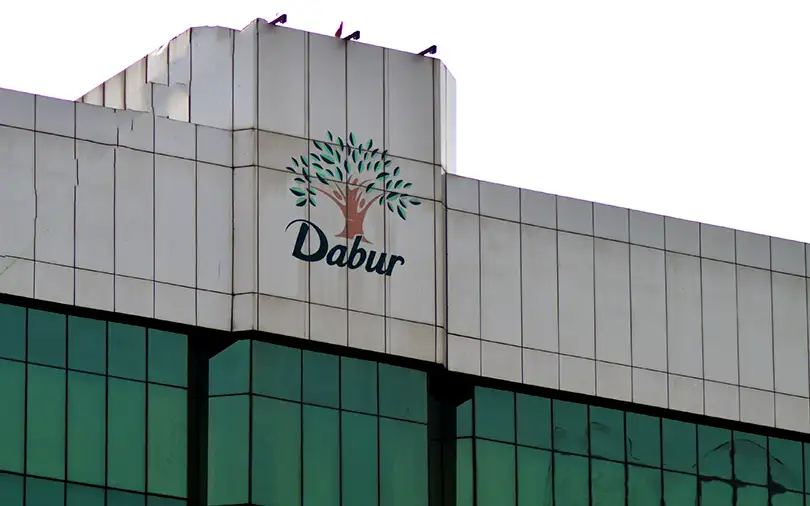Dabur Shares Tumble 4% as Q4 Profit Declines Amid Weak Market Demand
Shares of Dabur India Limited, a prominent player in India’s fast-moving consumer goods (FMCG) market, experienced a sharp decline of 4.36% on May 8, 2025, dropping to ₹461.1 per share. This marked the biggest intraday fall for the stock since April 7, 2025. The drop in share price followed the release of the company’s fourth-quarter (Q4) financial results, which showed a decrease in profits, largely driven by a slowdown in consumer spending and increasing costs.

Q4 Results: A Mixed Financial Picture
Dabur India’s financial performance for Q4 of FY2025 revealed a contraction in profit, despite a modest rise in revenues. The company posted a profit of ₹400 crore, which represented a 7.4% drop from ₹432 crore in the same quarter of the previous year. While this decline raised concerns among analysts, Dabur did report a 5% increase in quarterly revenue, which reached ₹2,500 crore, compared to ₹2,380 crore in Q4 FY2024.

The revenue growth, though encouraging, was overshadowed by the drop in profitability, which analysts attribute to several factors, including weakening demand for Dabur’s products in certain categories and higher input costs. Despite this, the company managed to grow in sectors like health and personal care, which remain integral to its business.
Impact of Sluggish Demand on Growth
The primary driver behind Dabur’s reduced profits has been slower consumer demand, especially in rural and semi-urban markets. Over recent months, economic pressures such as inflation, higher fuel prices, and a general slowdown in discretionary spending have led to cautious buying patterns. Consumers are becoming more value-conscious, focusing on essential goods rather than premium items, which has significantly impacted sales of Dabur’s higher-end offerings.
Dabur’s CEO, Mohit Malhotra, acknowledged the impact of these economic conditions in a statement, noting that rural demand, in particular, has been under pressure. “We are seeing a challenging demand environment, especially in smaller towns. Our approach to addressing this involves focusing on affordable products and increasing our presence in both rural and urban markets,” Malhotra said.
Margin Pressures Amid Rising Costs
Alongside lower demand, Dabur also faced significant pressure on its profit margins due to rising raw material and operational costs. The company’s gross margins for Q4 shrank by around 2%, mainly driven by the higher prices of inputs such as packaging materials and key herbal ingredients used in its Ayurvedic products.
Although Dabur made efforts to offset some of these cost increases by adjusting prices, the overall impact on its margins was substantial. As a result, the company’s operating profit margin decreased to 18% from 20% in the same quarter the previous year. This margin contraction was a key factor in the overall decline in profits, despite the revenue boost.
Dabur’s Strategy for Navigating Challenges
In light of the current challenges, Dabur has emphasized its focus on diversifying and adapting its product offerings. The company has been expanding its presence in rapidly growing segments such as health supplements, organic beauty products, and wellness solutions, which have been less affected by the current slowdown in demand.
Dabur has also been increasingly targeting international markets to offset domestic pressures. The company’s international business grew by 7% in Q4, particularly in regions like the Middle East and North Africa (MENA), where there has been strong demand for its product range. Despite these international gains, Dabur’s focus remains on the domestic market, where it intends to boost its marketing and distribution efforts to enhance its reach.
Looking Ahead: A Cautiously Optimistic Outlook
Despite the disappointing Q4 performance, Dabur remains cautiously optimistic about its future prospects. The company plans to continue investing in new product innovations, particularly in the areas of health and sustainability, to capture emerging consumer trends. Moreover, Dabur is placing a greater emphasis on its digital strategy, recognizing the growing importance of e-commerce in reaching consumers.
That said, analysts suggest that the immediate outlook for Dabur remains uncertain. The FMCG sector, in general, faces challenges like inflationary pressures, rising input costs, and unpredictable demand. In this context, Dabur’s ability to navigate these challenges will likely determine its performance in the coming quarters.
Stock Market Reaction and Investor Sentiment
The market’s reaction to Dabur’s Q4 results was negative, with the stock dropping sharply by more than 4%. Investors were primarily concerned about the decline in profits and the potential for continued margin pressures. Analysts have downgraded Dabur’s stock from “buy” to “hold,” citing risks related to the weak demand environment and rising costs. However, many still consider Dabur a strong player in the FMCG space, pointing to its well-established brand, diverse product portfolio, and strong distribution network as long-term strengths.
Conclusion
Dabur India’s performance in Q4 FY2025 underscores the challenges facing the FMCG sector in India. While the company saw a rise in revenue, the decline in profit highlighted the difficulties posed by weak consumer demand and escalating costs. Looking ahead, Dabur’s ability to innovate, expand its product offerings, and adapt to the evolving market conditions will be crucial to sustaining growth and maintaining profitability. For now, investors will be watching closely to see how the company navigates the current economic pressures and whether its strategies will pay off in the long term.






